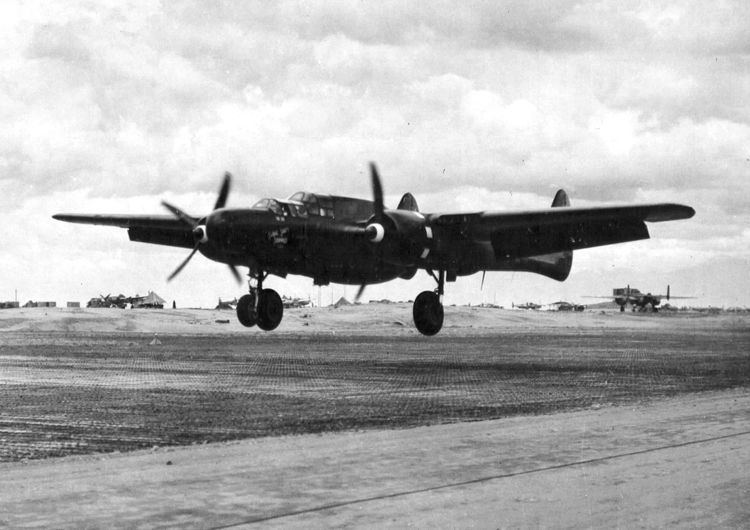Active 1944–1946; 1947–1949 | Country United States | |
 | ||
Role Command of tactical aircraft Engagements Southwest Pacific Theater | ||
The 309th Air Division is an inactive United States Air Force organization. Its last assignment was with Continental Air Command, assigned to Twelfth Air Force at Hensley Field, Texas. It was inactivated on 27 June 1949.
Contents
The division was first activated in 1944 in New Guinea during World War II as the 309th Bombardment Wing. The wing acted as a task force headquarters controlling forward based units of Fifth Air Force in New Guinea and during the Liberation of the Philippines. Following the war, it moved to Japan and served as part of the occupation forces until inactivating in March 1946. It was activated again nine months later in the Air Force Reserve.
World War II
The division was first activated in February 1944 at Lae Airfield, New Guinea as the 309th Bombardment Wing and assigned to Fifth Air Force. Although called a bombardment wing, the 309th operated as a task force, commanding the forward elements of Fifth Air Force. The 309th replaced the provisional 2d Air Task Force, which was organized on 2 August 1943 to serve as the forward element of the Advanced Echelon of Fifth Air Force in the Tsili Tsili area of New Guinea. The wing's combat components included bomber, fighter, reconnaissance and special operations groups and their supporting organizations.
The wing's bomber and fighter units attacked shipping, coastal installations, storage buildings, gun positions and airfields. When possible, Japanese troop concentrations were also attacked. Its tactical reconnaissance units flew numerous photographic missions. In July, the wing moved forward to the Schouten Islands, initially occupying Kornasoren Airfield, which aviation engineers rebuilt as a heavy bomber base after its capture from the Japanese. The 309th began operations supporting the Liberation of the Philippines in November.
In late January 1945, American forces landing on Luzon seized San Marcelino Airfield, and the wing installed the 348th Fighter Group and elements of the 421st Night Fighter Squadron and 3d Emergency Rescue Squadron there, moving its headquarters to the base on 8 February. Starting in the spring of 1945, the wing's units concentrated on providing air support for XI Corps. Operations included providing support to guerilla forces engaged behind Japanese lines. The 309th remained in the Philippines for the rest of the war.
Fifth Air Force began to engage in the bombing of Japanese bases on Formosa as the Philippine Campaign progressed to cut enemy supply lines from the north. Wing North American B-25 Mitchells struck these targets while its fighters escorted bombers on these missions.
Following VJ Day, the 309th moved to Japan, where its personnel systematically destroyed Japanese military aircraft and equipment for which the United States had no use. it supported aircraft that staged through Chitose Airfield on their return to the United States. It also flew surveillance flights with North American P-51 Mustangs over northern Honshū and Hokkaido. The wing was inactivated in Japan during in late March 1946.
Air Force reserve
The wing was reactivated as a reserve unit under Air Defense Command (ADC) in January 1947 at Hensley Field, Texas. It was assigned no groups until October, when the 455th Bombardment Group at Hensley was assigned to the wing. At the end of March 1948, the 446th Bombardment Group was activated at Carswell Air Force Base and assigned to the wing. The groups were designated as very heavy units and were nominally Boeing B-29 Superfortress units. However, there is no indication that the 455th Group was equipped with tactical aircraft. The 446th Group was located at a regular Air Force base, which gave it access to aircraft stationed there.
In 1948, Continental Air Command assumed responsibility from ADC for managing Air National Guard and reserve units. When the regular Air Force implemented the wing base organization system, which placed operational and support units on a base under a single wing that same year, the 309th Wing, along with other reserve wings with combat groups on multiple bases, was renamed an air division.
The 309th participated in routine reserve training and supervised the training of its assigned groups with the assistance of the 2596th Air Force Reserve Training Center until it was inactivated, in part due to President Truman’s 1949 defense budget, which required reductions in the number of units in the Air Force. With the inactivation of the division and the 455th Group, most of their personnel were transferred to the 443d Troop Carrier Wing, which was simultaneously activated at Hensley.
